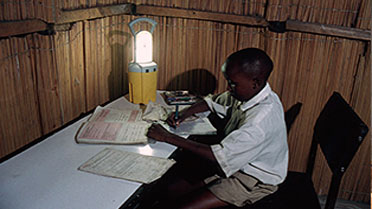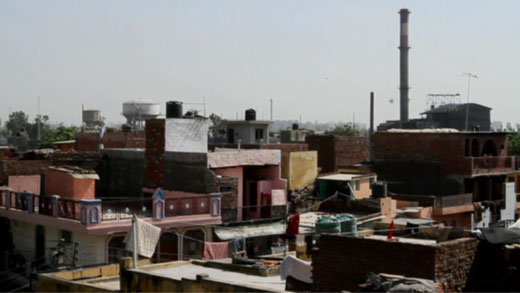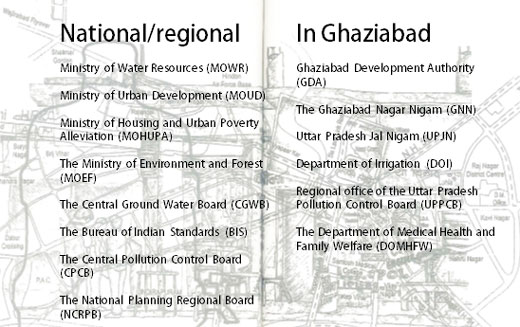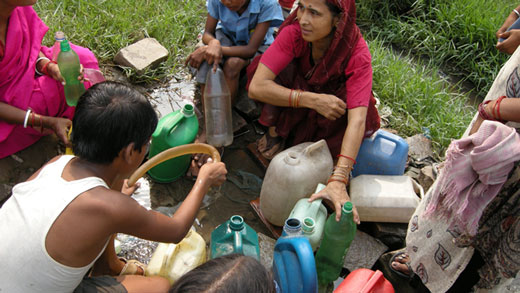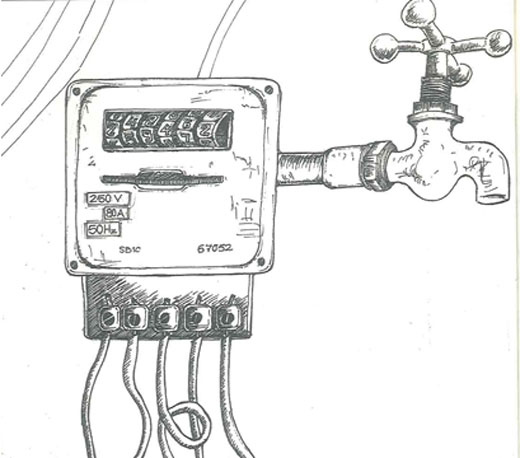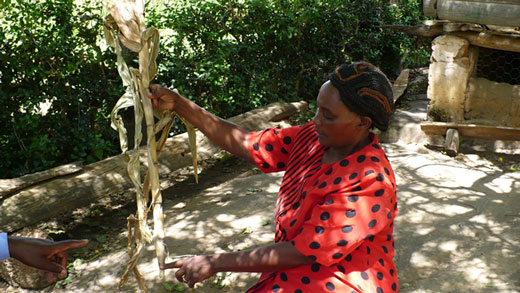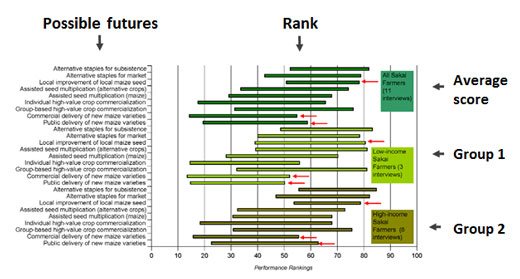by
Ruth Hall, Associate Professor, PLAAS.
How should African politicians respond to the ‘land rush’?
Parliamentarians from the member states of the Central African Economic and Monetary Community (CEMAC) met last week to debate this question. The two-day meeting was held in Malabo, the capital of Equatorial Guinea, and was convened among others by the
Pan African Parliament, the
International Institute for Sustainable Development (IISD), the
Institute for Poverty, Land and Agrarian Studies (PLAAS), and Future Agricultures.
You can download the
programme (pdf) and the
final declaration (pdf) from the event.
As private investors’ interest in African agriculture grows, African states need strong policy and legal frameworks in order to benefit from it: both in order to ensure that local people’s land, water and other natural resource rights are protected, and to provide a secure environment for private investments. This means renewed attention to land and other tenure reforms – the kind that the FAO’s
Voluntary Guidelines and the G8’s
Land Transparency Initiative are designed to support.
This article summarises the discussion, including the recommendations from the Malabo meeting.
A collective response to agriculture and food security is needed
The Honourable Hon. Vincent Mavoungou Bouyou, president of the CEMAC parliament, opened the event. Honourable Gaudencio Muaba Mesu, speaker of parliament in Equatorial Guinea, welcomed parliamentarians and academic researchers to the new CEMAC parliament building, and called for the meeting to generate ‘pragmatic recommendations’. “We want national and international organisations to work together to respond collectively to these challenges. Our citizens are threatened by this problem. We need to tackle agriculture and food security so that communities can benefit”, he said.
The first Vice President of the Pan African Parliament, Honourable Roger Nkodo Dang of Cameroon, presented an argument in favour of the ‘industrialization’ and commercialization of agriculture:
“We really need to attract investments in the agricultural sector and members of parliament need to work on that… It is very important for us to work to find the solution for food shortage that we have. Most African countries have an old-fashioned agriculture. The industrialization of agriculture is very important. We need to have great areas of land to use agriculture. We see that when Africans do agriculture, it is not the type of agriculture that is bringing development. We have great, great areas of forests, and we need to work so that we can use those lands. How we reconcile the development with the people who are in rural areas?”
What land deals are underway in Central Africa?
Ward Anseeuw of the University of Pretoria and Agricultural Research for Development (CIRAD) provided an overview of large-scale land-based investments in Central Africa.
About 4 million hectares of land in the Central African region has been leased out to foreign and multinational companies since the mid-2000s. This means that it is less affected by large-scale land-based investments than other regions such as East and Southern Africa – but nevertheless the scale of the land being transacted is substantial in several countries, like the Republic of Congo, Chad, Gabon, Central African Republic and Cameroon. At the same time, a further 4 million hectares was transacted in the Democratic Republic of Congo (DRC), alone (DRC is not officially part of the CEMAC region).
Forestry and palm oil dominate land deals
Investments for the production of food is minimal, yet all countries in the region are net food importers. Some are heavily dependent on imports, with over 90% of national food supply coming from elsewhere.
Where land deals have been struck, these are mostly for forestry – often involving harvesting of hardwood trees from the tropical rainforest – but also for agriculture. The major agricultural investments in the region are for the production of palm oil, often on large swathes of land where the forest is clear-cut. Despite hopes of benefitting from the UN Reducing Emissions from Deforestation and Forest Degradation programme, this has not materialized, according to delegates in Malabo. “None of the countries of the Congo Basin have received the carbon money”, said Honourable Ndang of the Pan African Parliament. So while large areas of forest are being sold off or leased out, incentives under REDD to preserve the forest and its ecosystems services are ineffective.
Water, climate change and shrinking Lake Chad
While part of Central Africa is well endowed with water (such as Gabon), other regions are water-scarce (such as Chad). Yet land deals across all countries involve ceding water rights over long periods of time.
“In terms of water, there is not good information, but there is a correlation between acquiring water rights and investing. In the Niger and Nile Basins, the correlation is very strong. Infrastructure and markets are also important.”, noted Anseeuw.
Honourable Bubakari from Chad observed that there is “huge potential for agricultural intensification”. The ecosystem of the Lake Chad basin, spanning four countries, is hugely valuable in the form of fishing, irrigated crop production and other production systems. Here, the rapid shrinking of the lake was adding to conflicts between farmers and pastoralists, and a regional response by all affected states was needed.
Matt McCandless of IISD argued that, in order to preserve Lake Chad, “ecosystem services need to be protected and trade-offs between investments and outputs, and ecosystems services need to be managed”. Investment contracts need to include explicit provisions on ecosystems services, especially the rights of downstream water users.
MPs agreed. One said: “We want to work also to tackle this issue of Lake Chad so that we can save the waters we still have. There are conflicts between herders and those in agriculture. We see that those conflicts are growing and we don’t want those conflicts to affect the investors. We need to preserve every opportunity for reconciliation, so that investments remain. We need to do everything to attract investors and when they come, they should also preserve the social and cultural realities of each country, for the welfare of our people.”
Who are the investors in Central Africa?
There is a widespread view that Chinese companies are at the forefront of large-scale land deals in Africa. However, in Central Africa, the major investing countries are the traditional powers of France, USA, Canada and Belgium – as well as a growing number of domestic investors, sometimes in partnership with international capital. In Cameroon, for example, domestic investors are more predominant. But, whether domestic or foreign, some similar challenges arise.
Land deals and climate change
This is an urbanizing region, aggravating the need to scale up food production. “Many people are leaving rural areas to come and live in cities, and so depend on others to produce food”, said Iyebi-Mandjek. “After the Amazon, there is the jungle of Central Africa, which is very important as a global resource. If we keep on abusing this forest, it will contribute to global warming. We must fight global warming and preserve biodiversity."
Investment and production, but for which markets?
What markets are supplied? Production by foreign investors is often for foreign markets, not for domestic markets. They are mostly motivated to gain profit through global markets. If someone is producing rice, they want to sell the rice at the highest possible price, and derive profit – which might not be in local markets. So local people might not benefit from increased production in their vicinity.
Whatever investment comes, it must first of all meet local needs – for instance, palm oil production must contribute towards energy security for local people, rather than going as renewable fuel for the cars of Europeans.
“Central Africa needs investment in agriculture to reduce food shortages. There is a need to adapt land laws to the new situations that we face. We need to go from family agriculture to mass agriculture because family agriculture is not really able to meet the needs of the people. It does not boost the agricultural market”, noted Iyebi-Mandjek.
Impacts of land deals on African farmers
 Invest in African farmers rather than giving away their land, argued Alangeh Romanus Che, of the Regional Platform of Farmers’ Organisations of Central Africa (PROPAC), a network of membership-based farmers’ associations across 10 countries in Central Africa. PROPAC, a supporter of the African Union’s Land Policy Initiative and its Nairobi Plan of Action, as well as the FAO Voluntary Guidelines, called for transparency and inclusive processes in governing large-scale investments.
Invest in African farmers rather than giving away their land, argued Alangeh Romanus Che, of the Regional Platform of Farmers’ Organisations of Central Africa (PROPAC), a network of membership-based farmers’ associations across 10 countries in Central Africa. PROPAC, a supporter of the African Union’s Land Policy Initiative and its Nairobi Plan of Action, as well as the FAO Voluntary Guidelines, called for transparency and inclusive processes in governing large-scale investments.
The lack of land reforms and of participatory governance meant that existing farmers were largely locked out of key decisions that would affect them:
“Farmers do not have a voice in land management. Some farmers are displaced and land seized to be sold to multinationals for foreign direct investment, and no rehabilitation process is put in place. There are serious deficits in the negotiations processes over land deals”, said Che. “All farmers depend on land as their principal capital, any denial of this access will impact negatively on farmers. An ‘advanced form of slavery’ is being introduced as farmers are denied land rights which are given to foreign investors.”
The outcomes of elite-based land investments were a decrease in local farmers’ output, leading to declining incomes, increased food and nutrition insecurity, a decrease in the employed labour force, increase in social conflicts, and growing hunger and abject poverty in rural areas.
Similarly, Dr Naomi Kipuri of the Arid Lands Institute showed how when governments tell investors that the land is under-utilised or idle, existing land uses including secondary uses (mostly by woman and pastoralists) go unnoticed. Water, firewood and traditional medicines are secondary uses that are often ignored when land deals are struck. The commercialization and monetization of land undermines customary land rights and provokes evictions of pastoralists and hunter-gatherers. This produces landlessness, she argued, and the principle of ‘free, prior and informed consent’ contained in the FAO Voluntary Guidelines, is ignored.
Honourable Ndang of the Pan African Parliament confirmed the critiques presented at the meeting:
“The kinds of investments we are seeing in Central Africa are not really helping local people. When we look at those investments, there are also conflicts in those areas. When you have 200,000 hectares for agriculture to one person, there is a problem. More and more, the populations are left aside, and investors are taking all the profit… Someone is producing rice, but rice is expensive in local markets because investors are selling where he can get more profit.”
Can Africa help secure the world’s food supply?
At the same time that parliamentarians discussed the chronic dependence of their countries on food imports, presentations from foreign experts suggested that Africa’s agricultural commercialization was needed to respond to global food shortages.
Matt McCandless of the International Institute for Sustainable Development (IISD) pointed out that while food production has more than doubled since 1960, the amount of food available per person on average has grown and food prices have fallen, the number of hungry people is in fact increasing. He argued that in developed countries, agricultural potential has been fully developed, nearing the theoretical maximum of food production. “It’s in the developing countries and in sub-Saharan Africa that cultivable land is still ‘available’,” he said.
Agriculture is an industry worth a trillion dollars a year and contributes 25% of GDP in Africa. It is also the mainstay of people’s livelihoods: while 22% of the world’s population is in the agricultural labour force, this is far higher in Africa, where 60% of the population is employed or self-employed in agriculture.
Henk Jan Ormel, Vice President of the Association of European Parliamentarians with Africa (AWEPA), told the parliamentarians: “The world is looking to you: farming and agriculture is becoming more and more a geopolitical issue. The world population will rise from 7 to 9 billion people in the coming 20 years. The demand for animal protein will rise 70%. This will not come from Europe or United States, but from East Asia and sub-Saharan Africa.”
Farmers are the backbone of the rural economy, and if African states lost sight of this, they would end up chasing the farmers to the big cities. ‘The big demographic shift to the cities ends up with people in slums with no jobs, and then we are creating the revolutions of the future. By investing in people of the countryside, we are investing in feeding the world’, he claimed.
“How to feed the world? One of the answers is here in Central Africa,” said Ormel.
Preferential terms for investors means disadvantaging local farmers
Fiscal advantages for foreign investors were inequitable, MPs agreed. As Honourable Ndang stated: “Somebody who comes to invest is told: for the first five years you will not pay taxes. It’s a problem! This is happening in the whole of Central Africa. The national investors are not protected in this way.”
Another MP echoed this sentiment: “We as MPs need to know exactly what is going on in our countries in terms of foreign investment. The laws that are favourable to foreign investors are to the detriment of local investment. Our states are giving more favour to foreign capital than to national interests; are states complicit and against the interests of their own populations?”
The worst situations arise when local farmers are displaced, but investment does not materialize. MPs agreed on an urgent need to review existing deals, as many of them have not been implemented. “We need to know their status and reasons for them not working out the ways planned,” argued Che.
Secure women’s rights before negotiating with investors
Land reforms will need to provide women with independent land rights, as a basis for development, agreed many of the parliamentarians. Even though women contribute most labour to cultivation, few own their own land. As one MP observed:
“Women don’t have land, if a woman asks for land, the husband says well, she should go to her parents. She gets to her parents, [but] they say no, you are married, you must go to your husband! So we need a legal framework where women will be owners of land.”
With the commercialization of agriculture, people are being asked to renounce their traditional rights, observed Honourable Ndang. “The people who are living in that land are displaced. We should do something to preserve the traditional rights. The investors who want to use that land, should be made to respect the rights of the indigenous people living there. We need to update our legislation.”
As Kipuri insisted, invest first in farmers themselves and, where external investment is to affect people’s resource rights, the basic yardstick to be applied is this: compensation must leave people better off than they were before.
Transparency is a precondition for inclusive investments
The information collated by the Land Matrix, an international collaboration of research and civil society organisations, shows that contracts are not publicly available, and the terms of the deal are often shrouded from view.
Olivier Iyebi-Mandjek of the Paul Ango Ela Foundation (FPAE) and Catholic University of Central Africa (UCAC), relished the opportunity to provoke the parliamentarians, arguing that the lack of transparency was the major challenge in the region: “the one thing I think must be talked about is transparency”.
There was no transparency in the ways investments were made between investors and local officials. One of the problems we have is that we don’t have enough employment; investors might create jobs, but they are often insecure and seasonal, and local people do not benefit substantially.
“Our study shows that there is a great need for transparency in the way transactions are done, so that everybody will know what is going on, and be satisfied”, said Iyebi-Mandjek. “There are African politicians who have shares in foreign companies that are getting land – they should be punished. That is real corruption. Even traditional chiefs are involved.”
Frank words on transparency and politics
MPs were at times refreshingly frank. Patrick Mucheleka, an MP from Zambia and a member of the Pan African Parliaments, outlined problems with transparency and the role of electoral politics.
“Contracts signed between our government and investors are not well known; these are not done in a transparent manner. Most of us are not well informed. We need to use the AU protocols and charters and domesticate them within our own national land laws and land policies – and then ensure transparent monitoring and evaluation systems, because that is what we are elected to do. At the same time, we face challenges and constraints, as some of us come from ruling parties, so are we able to side with our people? We tend to side with our parties, for fear of the next election and pursue the party interests, rather than to the people who elected us.”
Other parliamentarians were also frank and forthright. As one participant observed: “As MPs, we have our own diversified livelihoods, and we become investors ourselves, and partner with foreign investors. Should we push for laws that protect the interests of our smallholder farmers?”
What should be done?
Investment is needed in agriculture, from both public and private sources. The question is what models of agriculture are being promoted, and what business models are being established.
Routes to commercialization ‘from above’, by importing capital in return for land and labour, tends to produce less broad-based benefits than schemes to promote reinvesetment of capital by those who already hold the land and labour. Drawing on case studies from Nigeria, Zambia and Ghana, I argued that these models matter, and more attention should be given to models of investment that enable accumulation from below, among small farmers themselves, rather than replacing them with large-scale corporate farming.
MPs agreed that Foreign Direct Investment (FDI) needs to fit into wider visions for commercializing existing farmers
.
“We should not rely entirely on FDI. Where there is a real need for FDI, it must done through responsible agricultural investment that respects local people’s rights, generates employment, promotes infrastructure, protects the environment, ensures social protection, and ensures food and nutrition security alone the lines of food sovereignty. And any form of investment must focus on infrastructure that will add value to local farmers,” said Che.
Among the main recommendations of the meeting were that:
- Governments should ensure that investment does not upset indigenous livelihoods and ensure women’s rights
- Give priority to investments that support rather than replace primary production systems
- Reform land tenure regimes to secure rights of indigenous communities and rights for women
- Regulate and control investments to ensure benefits to communities, especially women
- Ensure transparency and fairness in the conduct of investments
- Ensure protection and preservation of biodiversity and special natural assets
- Ensure observance of the principle of free, prior and informed consent for local people before FDI deals are concluded
- Support diversification of women’s economic activities and include value addition to products that benefit them directly
- Recognise the rights of indigenous pastoralists and hunter-gatherers
- Ensure that rural women and not just men participate in development activities.
An important role for parliamentarians
 Parliamentarians need to hold their governments to account, and push for investments on land and water and other natural resources which lead to technology transfer, quality job creation and improvements in livelihoods.
Parliamentarians need to hold their governments to account, and push for investments on land and water and other natural resources which lead to technology transfer, quality job creation and improvements in livelihoods.
MPs both from ruling and opposition parties need to have the same information, so that they can exercise proper oversight of governments; at present, the legislature is often locked out of key information required to ensure transparency, observed Wolfgang Pinklhuber of AWEPA, the Association of European Parliamentarians for Africa, a co-sponsor of the seminar.
As Honourable Mucheleka of Zambia and of the Pan African Parliament insisted:
‘We need land laws and policies that secure land rights for our people. We need to create linkages with the private sector, but it should be a win-win situation for our smallholder farmers as well as the investors themselves. Civil society needs to play a role: local NGOs and farmers’ associations, also linked with international NGOs that can support research to inform the types of investment we should promote.”


 Invest in African farmers rather than giving away their land, argued Alangeh Romanus Che, of the
Invest in African farmers rather than giving away their land, argued Alangeh Romanus Che, of the  Parliamentarians need to hold their governments to account, and push for investments on land and water and other natural resources which lead to technology transfer, quality job creation and improvements in livelihoods.
Parliamentarians need to hold their governments to account, and push for investments on land and water and other natural resources which lead to technology transfer, quality job creation and improvements in livelihoods.


